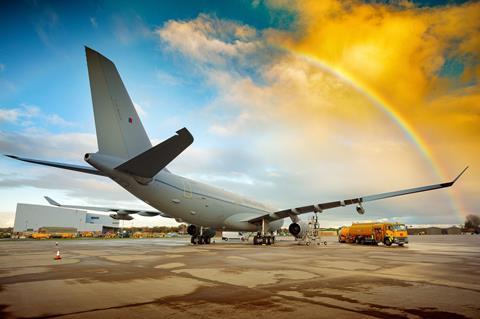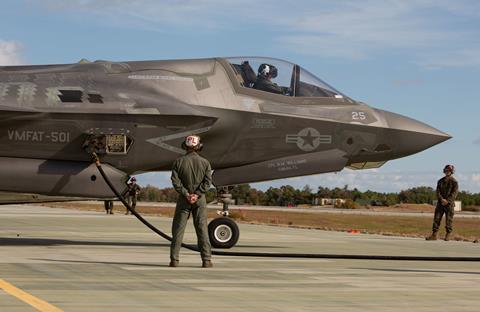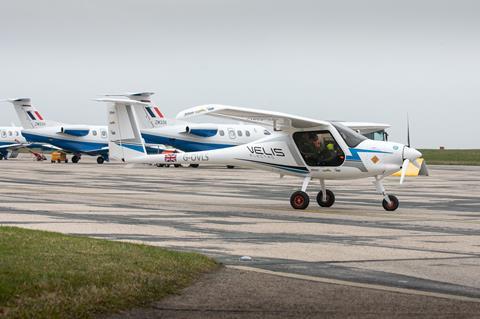Over the past six months, an Airbus Defence & Space A400M tactical transport, NH Industries NH90 multirole helicopter and a Eurofighter Typhoon have become the latest military aircraft to undertake test flights with sustainable aviation fuel (SAF).
They join a growing list of defence assets demonstrating the suitability of SAF as a drop-in fuel, replacing kerosene, that have taken to the air over the past decade and more. SAF is seen as the most critical ingredient in aviation’s mission to reduce its carbon emissions up to 2050 and beyond.
Air BP offers this explanation of why SAF is important: “SAF gives an impressive reduction of up to 80% in carbon emissions over the lifecycle of the fuel compared to the traditional jet fuel it replaces, depending on the sustainable feedstock used, production method and the supply chain to the airport.”
FEEDSTOCK SUPPLY
Typical feedstocks used to make SAF are cooking oil, animal waste fat, solid waste from homes and businesses and forestry waste, it notes.
Air BP is one of a multitude of SAF producers from the ranks of the traditional fossil fuel giants along with a host of start-ups keen to tap into what could become a huge market. Air BP was also the supplier of the SAF used in mid-January by a Royal Air Force (RAF) A330 Voyager tanker to achieve the first SAF air-to-air refuelling of a Typhoon and Lockheed Martin C-130J transport.

The defence sector is beginning to think about the influence climate change will exert on warfare and the platforms it operates.
One of the key questions, according to Dr Duncan Depledge, a lecturer in geopolitics and security at the UK’s Loughborough University, is: “Are there alternative ways of producing the same result for planes, tanks and ships in a more de-carbonised way?”
The alternative pathways are easy to describe. The first is alternative fuels, such as SAF, which require no engine modifications. The second is to change the way the war-fighting machines are powered by developing engines that use a low-carbon fuel source such as electricity or hydrogen.
The quest to discover alternative fuels is hardly new for the military, but the motivation before was different and not related to sustainability.
FORCED CHANGE
As Richard Aboulafia, managing director of consultancy AeroDynamic Advisory, observes, two of the biggest leaps in the development in synthetic fuels came under duress.
The first was by Germany during the Second World War when it used synthetic-oil manufacturing to make oil products from coal because it could not import oil from other sources. The second was in South Africa, where since the 1950s synthetic fuel has been made from coal, a capability started during the apartheid era to overcome the oil sanctions imposed by the UN.
Developing an entire industry from scratch in this way requires a lot of state money, says Aboulafia, drawing a parallel with the huge sums of government support that will be required today to establish SAF production globally.
Another attempt with alternative fuels took place in the late 1950s, when Lockheed’s famous Skunk Works unit used liquid hydrogen as a fuel in ‘Project Suntan’ to develop a long-range spy plane.
According to Michael Winter, principal fellow advanced technology at Pratt & Whitney, which was the engine developer for the CL-400 Suntan, while the project was cancelled, it enabled P&W to understand the challenges of making a gas turbine engine powered by hydrogen.

P&W is one of several engine innovators revisiting hydrogen today. “We went back to the technology from Project Suntan and we’re now working on a hydrogen engine variation on that cycle,” says Winter.
While the motivation to find alternative pathways today is predominantly about reducing emissions, the strategic questions around fuel and the need to maximise fuel efficiency are basically the same as in the past few decades.
“As far as sustainability is concerned fuel burn has always been important to the military,” says Winter. “Just as with commercial aviation where 30-40% of the cost of running an airline is fuel, it’s the same when running a modern air force. In addition, fuel security matters in terms of [operational] independence, mission readiness and long-range supply lines.”
In commercial aviation the motivation to reach net-zero emissions by 2050 is coming principally from the customers: the airlines. In defence, it is always about “mission first” – but the question of sustainability is emerging in military aircraft competitions, says Winter.
“This is an issue right now. When we go into foreign military campaigns for F135 engines, among the 15 allied operators that we have for the [Lockheed] F-35 we now have countries asking us and the OEM to perform life-cycle analyses on the engine and on the aeroplane,” Winter says.
For instance, in Switzerland’s recent fighter competition, which featured a public referendum on the aircraft choice, “there were hearings that included discussions about the sustainability and fuel burn associated with the various options for the Swiss air force,” explains Winter. These considerations are mostly prevalent in Europe and emerging in the USA, but will grow, he adds.
Aboulafia draws on a historical comparison to highlight another strong motivation for the military to act. “If you are looking at a change in fuel source you want to be at the leading edge of the transition,” he believes, pointing to the example of British Sea Lord Jackie Fisher, who championed the switch from coal to oil as the major type of warship fuel in the lead up to the First World War.
“You want to be free of vulnerable fuel sources and he [Fisher] could see a point where the alternative succeeds,” he notes.
As the defence sector recognises and makes the slow turn towards sustainability, practical questions on the transition are being asked. The challenge for defence is more complex than in the commercial world.
“The defence sector has peculiarities as countries approach this challenge in a different way and at different speeds,” says Jose Antonio Coll Guzman, head of sustainability at Airbus Defence & Space.
“Depending on the product, different options and technologies for decarbonisation need to be addressed to find the right balance,” he says, ensuring the technology is right for the mission. “Many defence products have a long lifespan, which means that, on one hand, sustainable solutions for existing products are required, but also, new product developments need to consider eco-design and ensure adaptability for the future.
“For this, availability, cost and the development of an ecosystem in the case of SAF for example is an important element to be considered, as is the identification of standards and for governments to support industry in the inclusion of eco-design parameters in the specifications and needs of new product development,” says Guzman.
“As many programmes tend to be adopted by multiple nations, funding and workshare could raise the complexity of implementation.”
The spectre of complexity tends to mean higher costs, which can derail innovation. This is where government support is essential to signal, regulate and subsidise the transition.
PRODUCTION SITES
In late 2022, the US Department of Defense (DoD) was tasked to prepare a plan for increasing the production and use of SAF in the Pentagon’s aviation operations. Under the 2023 National Defense Authorization Act (NDAA), the DoD will have one year to identify at least two “geographically diverse” sites within the current US military footprint to carry out a pilot programme on SAF use.
Following an initial year to identify test sites, the DoD is required to generate a plan for using a jet fuel blend of at least 10% SAF by 2028 at these bases.
The US military has been involved in the development of SAF for over a decade. In 2010 an unmodified US Navy Boeing F/A-18F Super Hornet flew from NAS Patuxent River in Maryland powered by a 50:50 blend of sustainable biofuel and jet fuel.
At the time, Boeing said that “operating navy platforms with renewable energy sources such as sustainable biofuels are part of the service’s strategy to reduce reliance on fossil fuels by half over the next decade”.
That aspiration has not been met, but throughout this period the US military has continued its strong support in the research and development and fuel qualification phase for SAF, explains Steve Csonka, executive director of the Commercial Aviation Alternative Fuels Initiative (CAAFI).
Formed in 2006, CAAFI is a coalition of airlines, aircraft and engine manufacturers, energy producers, researchers, international participants, and US government agencies leading the development and deployment of alternative jet fuels for commercial aviation.
PRICE MATTERS
Turning the military’s interest in SAF into joining airlines in buying it is the next stage, but by no means easy. Firstly, the US military is legally obliged to acquire fuel based on price. There are the seeds of legislation in the US system that may allow SAF to be bought in the future, but for now its use is limited to a few trials.
Secondly, if SAF is acquired, and it is more expensive than regular jet fuel, in a finite budget world the military may have to cut back elsewhere to balance the books. This is problematic if mission capability is degraded or spending on platforms is curtailed.
“There are a lot of people in the industry who really hope for progress and to see the services become a large buyer of SAF,” says Csonka. “And while it is a question of when, not if, the question can be asked: will the military be the last purchaser of SAF? Or will the recent NDAA mandate to evaluate various options for SAF supply initiate an earlier uptake?”
While FlightGlobal’s research has not found any military forces regularly using SAF, there are many military models on the path of testing and certification, including with the Japan Air Self-Defence Force and the Republic of Singapore Air Force, and there are infrastructure developments. From January, the NATO Central Europe Pipeline that supplies Brussels airport with kerosene was opened for the transport of SAF.
In parallel there is a frenzy of R&D work around disruptive propulsion technologies with direct applicability between the work being done in the civil world to military platforms, says Winter. All of P&W’s military engines are approved for SAF use based on today’s fuel specifications and the F135 engine for the F-35 has run on 100% SAF.

“When you look at a military, and when you look at a commercial engine, they both have fans, compressors and combustors,” says Winter. “There are some nuanced differences, but the way you optimise one and the way you optimise the other are similar; you are relying on the same physics and the same chemistry.”
P&W is among all the majors and a plethora of smaller players working on electrification, hybrid-electric and hydrogen powerplant technologies. For instance, Pratt & Whitney Canada is leading development of a hybrid powerplant, which incorporates a 1MW electric motor to equip a De Havilland Canada Dash 8-100 with the system. It is planned to fly in 2024 and is targeting a 30% reduction in fuel burn and carbon dioxide emissions compared to today’s turboprops.
“Those same technologies have direct applicability [to military platforms],” explains Winter. “In terms of larger engines, we’re also looking at that sweet spot of around one megawatt. The military would love another megawatt of power on board – that’s an order of magnitude more than they have on board fighters today.”
The extra electrical power could be used for an electronic warfare suite, for directed-energy weapons or for silent operations, he notes.
AIRFRAME EFFICIENCIES
While much of the focus is on disruptive propulsion solutions to decarbonise military aircraft, the OEMs are seeking efficiencies from airframes as well.
“This journey doesn’t stop here,” says Guzman. “We keep improving our aircraft with initiatives like Herwingt (Hybrid-Electric Regional Wing Integration Novel Green Technologies), which is a [EU] Clean Aviation project focused on the design of a more performant wing for military aircraft.”
The idea of not flying altogether is another prospect by using synthetic training as an alternative to avoid flight testing and training emissions, says Guzman.
“By nature, our products and services contribute to reducing the carbon footprint of our customers,” says Helene Gagnon, chief sustainability officer at global training giant CAE. “It is estimated that one minute of live training in a Eurofighter generates as much carbon emissions as a full day in the same platform simulator.
“Although simulation will not take the place of live flight training, it allows students to practice and master abilities, making live flight training more effective and efficient, supporting our environment and our customers,” she says.

Elsewhere in the military training world, the RAF and the Royal Danish Air Force have been trialling the use of Pipistrel’s all-electric Velis Electro two-seat trainer with a view to replacing traditionally-powered types.
There are many opportunities for the defence sector to decarbonise, but clearly many complexities and challenges too.
The question of sustainability has arrived front and centre on the agenda for military leaders. Progress is too slow for some, however just as in the commercial aviation arena the bandwagon is rolling and cannot be stopped.
Could fuel made from air make the grade?
The prospect of producing sustainable aviation fuel utilising embryonic carbon transformation technologies has led the US Department of Defense to begin work with a start-up in this field to explore the opportunity.
The deal in February saw developer Air Company awarded a contract with a ceiling value of $65 million from the Defense Innovation Unit to produce Airmade jet fuel at certain selected US Air Force (USAF) bases.
Air Company notes that the USAF is currently identifying and developing potential sites suitable for its Airmade SAF production across the USA, to be available ahead of 2030.
In mid-2022, the USAF and Air Company kicked off their partnership with a flight demonstration of a small, unmanned jet powered 100% by Airmade SAF in a project called Fierce.

Air Company produced five gallons of SAF using its carbon utilisation technology. This features its carbon conversion reactor system, where carbon dioxide captured from industrial plants is combined with green hydrogen. There are further steps involving a catalytic converter to finish with a SAF that Air Company claims has an emissions reduction potential as high as 99%, depending on the low-carbon electricity source used.
“In addition to its sustainability benefits, our technology enables strategic control of fuel supply and availability for our partners,” says Stafford Sheehan, Air Company’s chief technology officer and co-founder.


























